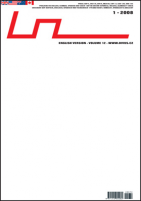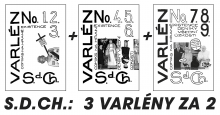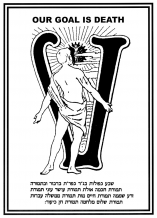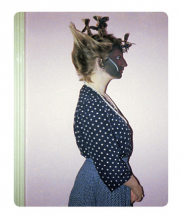| Umělec 2008/1 >> Joe Coleman | Просмотр всех номеров | ||||||||||||
|
|||||||||||||
Joe ColemanUmělec 2008/101.01.2008 Nils Michaelis | profile | en cs de es |
|||||||||||||
|
Joe Coleman is not your typical “high brow” artist. His roots lie in the American punk music and cartoon scenes of the 1970s. The best part is that over the last fifteen years established collectors and well known galleries in New York and Paris have shown great interest in his work; even The New York Times has covered him in considerable detail.
Coleman’s last peak was reached in the summer/fall of 2007, when the Kunst Werke Institute in Berlin exhibited a comprehensive overview of his work. About forty pictures and several installations were set up throughout four floors of the gallery. Beginning in the high basement rooms, the exhibition basically presented the foundation of Coleman’s art: the Vaudeville-world of the turn of the century. With its travelling circuses, ghost trains, street ballad singers, waxworks and freak shows, it offered a varied selection of physical, spiritual and moral deformations to a happily shuddering audience. In the basement, the artist did not display his own works but bits and pieces from the era. Exhibited in a container which reminded us of the covered wagons used for the exploration of the American West, we also found a rape scene, recreated in wax, which had been shown at the Myrtle Beach Wax Museum in South Carolina for a long time. Or the figure of Richard Specks—a murderer who had killed eight nurse trainees in a frenzy. You could, of course, laugh all of this off as an old-fashioned little horror show and thereby distance yourself from the depths of the human soul on display. The pictures shown on the upper floors, however, testify to the fact that Coleman does not reduce horror to thrill. Murders, physical deformations and diseases reverberate in his work as depressing introspection. The title of the exhibition was, after all, “Internal Digging.” His pictures attempt to banish the nightmares that he creates. For Coleman, they function as voodoo altars on which sacrifices are made to pacify the demons. Take, for example, his self-portrait I Am Joe’s Fear of Disease, which portrays Coleman’s suffering from a skin disease in cartoon-like scenes and thus transfers the disease on to the artwork. And then there are lots of terrifying faces; primarily those directly taken from old and new albums of criminals. Some of them look guileless, like Osama Bin Laden in the picture As You Look into the Eye of the Cyclops. However, most of the faces—the George Grosz-like ones of War Triptych for one—seem degenerate, tortured, and injured. In the surreal style of Hieronymus Bosch, Coleman looks at the military edges of the superpower USA, where the American Dream turns into a very real nightmare. Moreover, Coleman’s eye for detail is outstanding, for he fills even the last square millimetres with finely painted texts and symbols. Painting something like that, we can only guess, requires either the patience of a Zen-Buddhist or pressing madness. The impressive force of Coleman’s pictures lies in the ambivalence to this terror which is poorly held in check. In the following interview Coleman explains how art can work as a method of self-therapy. Your pictures are often compared with the works of Art Brut-artists like the schizophrenic Adolf Wölfli. But in contrast to these autodidacts you had actually started an academic education, before you were kicked out of the art academy. Why did they throw you out? It was a review-committee that meets every semester. There were three judges. They described my work as being fascist and schizophrenic. Even if I was schizo... what does it have to do with the art?! The term “fascist” ... I mean, here is a review committee to decide if my work has any artistic value ... and I am the one that is supposedly fascist! It stirred up a lot of anger in me and I retaliated. It became impossible for me to continue. There was a reaction against figurative art in general at that time. Minimalist works were the ones that were respected. Figurative art was just illustration. After abstract expressionism there was this widely believed idea that figurative art had died because photography was much better at showing the real world. But to me that is all bullshit. If you look at the figurative art of Breugel or Goya, there is no photo that can capture that. You had an exhibition with Art Brut artist Adolf Wölfli. He seems to have made a strong impression on you. Where do you see the similarities, and where are the differences? You fill every square centimetre with signs, symbols and texts, which strongly reminds me of the Swiss painter. I can identify with his work. Because I don’t do any sketches, either—I work instinctively. I just add little bits and pieces until I’ve covered the entire surface. Sometimes I do research because paintings are like novels. When I painted a biographical picture of Boston Corbett1, I just did what any novelist does. I read interviews, looked up newspaper articles and tried to find court records about the case. I guess I identify with the idea that the image is not enough, that the text is important, too. So I am also interested in stories and letters. The way we perceive reality is with words, and words create images in our heads. So you can see both perspectives in my pictures. Can you give us an example—how about the picture about the country singer Hank Williams? I was contacted by his grandson, Hank Williams III. He was very moved by my work, and so he sent me photos from the family album. He sent me moonshine too (laughs). In the case of the Hank Williams picture, the feelings I got from these bits of information literally went right onto the surface, like bits of dialogue. And his actual lyrics and music make the frame of the painting. That’s how I paint. This form of painting also relates to the illuminated manuscripts of the middle ages where you find narratives plus text, plus images and symbols. And Tibetan art is like that, too. The religious art—they make these really flat paintings but they are incredibly dense with information. What role do drug experiences play? Your pictures let the viewer feel the spirit of things rather than their material surface. Ok, I was a heroin addict, and I have done every single drug you can imagine. So drug experiences are part of my life. Still, I wouldn’t say that I do drug art. I didn’t mean that you are making some sort of psychedelic art. It’s more that your paintings remind me of the perception you get when you take psychedelic drugs: you get the feeling that everything has some sort of spirit in it. I see what you mean, but it comes from my Catholicism, too. I was brought up an Irish Catholic. It think the Irish part of it is significant, especially this kind of pagan-Celtic twist on the Catholicism. It has all these icons, the worship of the Holy Spirit. The paintings I do are very much icons. But that’s the phoney kind of Catholicism. I don’t trust that. I was raised going to church but I lost faith in the rhetoric and the formal church. It’s full of hypocrisy. I just try to live my life to certain beliefs that I was taught. I live with my understanding of Catholicism. The ritual and the drama of it speak to me. I try to use that without being manipulated by it. There is this quote from you about your childhood… the story about the cemetery that made you afraid when you looked at it. Yes, I used to put one foot over the stone wall and then ran home. But I came back, and the next time I put two feet down, and eventually it was my playground. Is your art a way of coming back to things that are frightening you, a confrontation with all those little horrors of daily life? That’s certainly a big aspect of my work. It is a way of controlling my fears and desires and housing them in that bordered object that has magical symbols on it to protect you from them. Your fears are put into sharp focus, you can look at them, and that makes them a little bit less frightening. So they don’t destroy me. In your performance in New York, you yourself caused fear and panic when you pointed a gun at other people’s heads. I had to communicate that pain. I could not do it by singing a blues song. The only way to communicate what was going on inside of me was by pointing a shotgun at the audience. Was the gun really loaded? Yes, it was but with blanks. But when I fired, the audience didn’t know that and they ran. What did you feel at that moment? I felt a little bit better that I got some of the rage out. I don’t know, I felt kind of peaceful. You never felt the need again to point a gun at your audience? No, I never did it again. Why don’t you feel that pain anymore? Have your paintings and your performances worked as a sort of therapy in the end? Yes, the art helped, but I’ve also become older and more mature. And then, there is the love of a good woman. It is a combination of many things that helped me.
01.01.2008
Рекомендуемые статьи
|
|||||||||||||
|
04.02.2020 10:17
Letošní 50. ročník Art Basel přilákal celkem 93 000 návštěvníků a sběratelů z 80 zemí světa. 290 prémiových galerií představilo umělecká díla od počátku 20. století až po současnost. Hlavní sektor přehlídky, tradičně v prvním patře výstavního prostoru, představil 232 předních galerií z celého světa nabízející umění nejvyšší kvality. Veletrh ukázal vzestupný trend prodeje prostřednictvím galerií jak soukromým sbírkám, tak i institucím. Kromě hlavního veletrhu stály za návštěvu i ty přidružené: Volta, Liste a Photo Basel, k tomu doprovodné programy a výstavy v místních institucích, které kvalitou daleko přesahují hranice města tj. Kunsthalle Basel, Kunstmuseum, Tinguely muzeum nebo Fondation Beyeler.
|




































 New book by I.M.Jirous in English at our online bookshop.
New book by I.M.Jirous in English at our online bookshop.
Комментарии
Статья не была прокомментированаДобавить новый комментарий